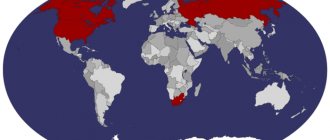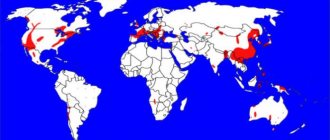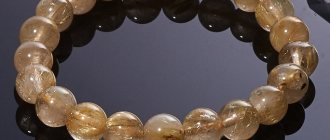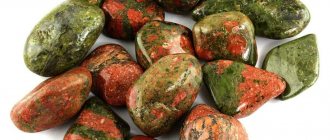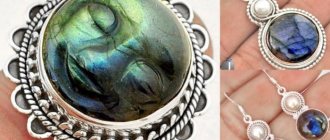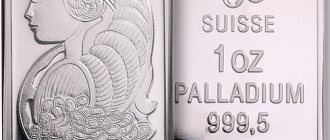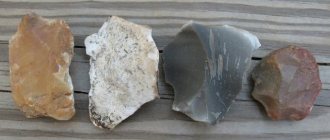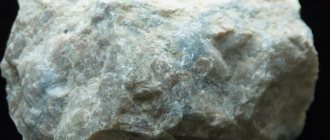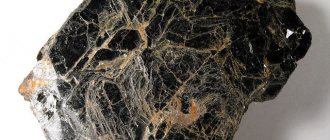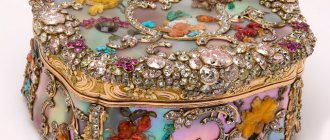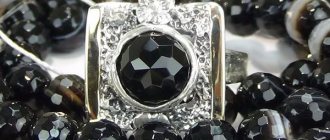Description of the stone and its origin
Orthoclase is classified as a potassium feldspar. More often it is contained in acidic or moderately acidic igneous or metamorphic rocks. The stone is often adjacent to albite, quartz, and mica. In igneous rocks it is also found together with hornblende, and in pegmatite veins with beryl.
Orthoclases are available in different sizes. These can be either small microliths or large stones several meters wide.
Orthoclase has been known to people for several millennia, but it received a scientific description only in 1823 thanks to the scientist August Breithaupt. He also gave the name to the mineral, which comes from the Greek language. The words "orthos" and "clasus" mean "straight" and "crack". This name is due to the right angle between the cleavage planes - the stone splits into rectangular fragments.
How to distinguish a fake?
Natural stone is characterized by minor flaws, such as inclusions, cleavage, and microcracks. To distinguish natural orthoclase from a fake, it is recommended to take a closer look at the stone, pointing it at sunlight or using a magnifying glass.
If upon examination a cleavage is discovered that gives an original refraction, bubbles or cracks, the conclusion arises that the stone is of natural origin. But if the stone has no defects, is absolutely clean and bright, then the sample is a fake.
Also read: Selenite - the secret magical properties of the stone
Main deposits
Orthoclase is found on all continents except Antarctica. There are many deposits:
- Australia;
- Austria;
- Asia - in jewelry they mainly use stone from India, Myanmar, and Sri Lanka.
- Brazil;
- Germany is the territory of the former Federal Republic of Germany;
- Zimbabwe - mining of blue-green mineral;
- Italy;
- Kyrgyzstan (Pamir);
- Madagascar – transparent yellowish stones are mined here, which are especially valuable in jewelry;
- Mexico;
- Russia – Transbaikalia, Kola Peninsula, Ural (Cherry Mountains, Ilmenskoye field), Khabarovsk Territory;
- USA;
- Czech Republic.
Orthoclase
ORTHOCLASIS
Orthoclase (from ancient Greek ὀρθός - straight and κλάσις - refraction) is a rock-forming mineral from the class of aluminosilicates: potassium aluminosilicate. One of the types of potassium feldspars. Named by German mineralogist August Breithaupt in 1823 due to the right angle between the cleavage planes. Chemical formula: K[AlSi3O8]. Orthoclase is not a rare natural formation. The mineral refers to variants of the common mineral feldspar. The significance of the stone for humans has not yet been fully studied, despite its long history. Scientists are discovering new properties of the stone and the facets of its perfection.
Properties of orthoclase
The luster is glassy, pearlescent, weathered varieties are matte. Hardness 6. Specific gravity 2.56 g/cm3. Color yellow, pinkish, red, white, grayish, less often colorless. Doesn't give a trait; weathered varieties give a white streak. Cleavage is perfect in two directions. The angle between the cleavage planes is straight. Solid granular, dense, inclusions, less often crystals, druses and twins. Monoclinic system. The crystals are ingrown and overgrown.
It is characteristic of orthoclase that its refractive index is lower than that of quartz, which makes it possible to separate these two minerals under a microscope in the zone of their contact by the behavior of the Becke strip.
Features. Orthoclase is characterized by a non-metallic luster, high hardness (leaves a scratch on the glass) and perfect cleavage in two directions. The angle between the cleavage planes is straight. Orthoclase can be confused with quartz. The difference is that quartz has no cleavage.
Chemical properties. Acids, except concentrated nitric acid, have no effect on orthoclase.
Varieties and photos of orthoclase
Adularia (ice spar) is colorless and transparent. Named after the area where it was first found: Mount Adula, Switzerland. Overgrown wedge-shaped crystals. Powdery green chlorite is often observed on the surface of crystals.
Sanidine is glassy, interspersed with tabular crystals.
Sunstone (heliolite) - has a golden sheen.
Moonstone - has a bluish silvery tint.
Origin
Igneous, post-magmatic and metamorphic origin. It is found in acidic igneous rocks: gneisses, granite pegmatites, syenites. Rarely found in greywackes (greywacke or gray wacke is a dark gray to brown sandstone containing fragments of various rocks along with quartz grains) and arkoses (clastic sedimentary rock of the sandstone type, consisting of grains of quartz and orthoclase).
The shapes, especially in porphyry phenocrysts, are tabular or elongated. In intrusive rocks they are usually irregular in shape. Sizes vary, from small microliths to large individuals up to several meters in diameter. A glassy, water-transparent variety of orthoclase, adularia, is found in druses of some crystalline schists.
Satellites. In igneous rocks and gneisses: quartz, albite, hornblende, micas. In pegmatite veins: quartz, albite, mica, topaz, beryl. Product of chemical change: kaolinite. Adularia satellites: quartz, albite, apatite.
Applications of orthoclase
Potassium feldspars are used in the ceramics industry - in the production of porcelain, earthenware, enamels, glazes and in the glass industry. Moon and sun stones are facing and ornamental materials of low importance. In high-quality jewelry-processed orthoclases, you can see the cat's eye effect and the star-shaped effect when illuminated.
Place of Birth
Orthoclase deposits are found in India (Madras), Sri Lanka, and the USA (Oregon). Heliolites are mined in Madagascar. In Russia, orthoclase deposits have been discovered in the Chelyabinsk region, Primorsky Kara, Khabarovsk Territory (Udacha deposit, Irnimiyskoye deposit, Ayano-Maisky district).
Orthoclase is widely used in the ceramic and glass industries. It is used to produce earthenware, porcelain, glaze and enamels, which subsequently serve as raw materials for the manufacture of dishes and all kinds of souvenirs. The mineral is the main component in the production of glass of high quality and strength. Electrical insulating properties make orthoclase popular in electrical engineering. In construction it is used as a finishing material. Orthoclase makes amazing decorative items and crafts. The mineral is used by lithotherapists and esotericists; amulets and talismans are made from it. Jewelers process beautiful transparent crystals into cabochons and insert them into various jewelry - earrings, rings, rings, pendants. The most valuable and rare specimens, distinguished by their purity, quality and brilliance, are exhibited in private collections.
Orthoclase amulets help preserve love relationships. Orthoclase changes color and fades, predicting the imminent end of a relationship, the breaking of close ties between partners. European mediums saw in the mineral the ability to protect the owner from unseemly steps, vicious deeds, and dark thoughts. Amulets prevent a person from making the wrong decision. The mind keeps emotions under control, especially negative ones. The meaning for a person is important and often very necessary.
Astrology advises poets to make amulets. Even an unprocessed piece of rock will become a source of creative strength and inspiration. Transparent orthoclase reveals vocal talent and artistic abilities. The amulet is often made for children in order to activate their inner talents and prevent them from remaining undiscovered. If a child has been shown to have the ability to draw, the mineral will help parents create the conditions for mastery.
Magic properties
The mineral orthoclase is credited with magical properties:
it is considered a strong amulet of love and acts as a protector of family relationships, which is why orthoclase is often given to newlyweds for a wedding; the stone can have a calming effect on the psyche, therefore it is recommended as a talisman for overly emotional people to keep them from rash actions and irrational decisions; the mineral enhances the creative component , therefore it can serve as an amulet for people working in the field of art - poets and writers, artists and performers, giving them new creative strength and inspiration.
Medicinal properties
Lithotherapists recommend using the healing properties of orthoclase for:
normalization of the psycho-emotional state, general strengthening of the body, increasing immunity, preventing cancer, reducing the amount of toxins contained in the body.
Varieties
Orthoclase is divided by appearance. The most popular moonstone (adularia) is bluish in color. It has the most pure composition. Specimens of a soft silver hue mined in Sri Lanka are especially prized.
In moonstone, orthoclase alternates layers with albite, providing the characteristic effect of this variety. The mineral can be slightly transparent or semi-translucent. For this type, the cabochon-dome cut is preferred. Sometimes there is a cat's eye effect.
Helpful information
Adularia gets its name from the Italian Adula Mountains, where it was first discovered. It is also mined in Switzerland (Alps). It is also called ice spar.
A yellow or reddish colored variety of orthoclase is called sunstone. The cut gives it a golden shine. There are many deposits, but especially large specimens are found in Madagascar - the weight after cutting exceeds 100 carats. The reddish mineral is also called erythritol, and the yellow one is ferriorthoclase.
Another type of orthoclase is sanidine. This is the name given to stones of glassy gray or beige color. They are mined mainly in the USA and Germany. This type of mineral is characterized by inclusions of tabular crystals.
Greenish orthoclase is called lennilite.
Orthoclase can have an iridescence effect, when in bright light a rainbow-colored glow is visible on an even chip. Specimens with a pearly-grayish glow are called wolf's eye. The effect is especially pronounced after polishing.
Mining locations
Orthoclase is found in volcanic deposits, granitic and metamorphic rocks.
Raw materials are mined in the USA, Scandinavia, Madagascar, and Sri Lanka.
Russian production regions - Khibiny, Ural.
The material of different deposits differs:
- Stones from Sri Lanka are identified by blue adularescence.
- Semi- or fully opaque pastel colored gemstones with a lunar effect or a cat-eye stripe are supplied by India.
- Yellow, golden orthoclase comes from Madagascar.
- Transparent sea-green feldspar melts from African pegmatites (Zimbabwe). It is passed off as aquamarine.
- Sources of sanidines are the USA and Germany.
In the Alps on the Swiss-Italian border, adularia are still mined.
Physicochemical characteristics
The chemical formula of orthoclase is K(AlSi₃O₈). Almost 65% of the mineral consists of silicon dioxide. It also contains other elements:
- aluminum oxide (18.5%);
- potassium oxide (17%);
- sodium oxide;
- isomorphic impurities - possible presence of aluminum, barium, iron, calcium, rubidium.
The appearance of orthoclase crystals can be tabular, columnar, or prismatic. The mineral has the following physical qualities:
- hardness 6-6.5 on the Mohs scale;
- density 2.56 g/cm3;
- refraction 1.52;
- the luster is glassy, but untreated specimens do not shine;
- the coloring is usually uneven, spotted;
- stones are often opaque; a translucent mineral with transparent parts is rare;
- in ultraviolet light it is pale blue or orange luminescence, in x-rays it is white or violet;
- monoclinic system;
- the fracture is stepped or uneven;
- fragility;
- difficult to fuse;
- solubility in nitric acid, decomposition in fluoric acid;
- low optical relief;
- cleavage perfect in one direction and average in the other, the angle between its planes is straight.
How to care for orthoclase products?
Any mechanical damage is dangerous for orthoclase due to its fragility. For the same reason, it is better to store jewelry with a mineral separately from other jewelry in a box or case with velvet inside.
Since orthoclase dissolves in acid, chemical elements can harm jewelry made from it. Remove dirt from jewelry using a soap solution in running water, and dry at room temperature.
Direct sunlight and hot air currents destroy the structure of the mineral, which can cause it to fade.
Magic properties
Orthoclase is endowed with mystical powers:
- protection of the family hearth, marriage;
- suppression of groundless jealousy;
- mood lifting;
- neutralization of a violent emotional outburst, a depressive state;
- awakening of love - the stone cannot be used for a love spell, but it helps to determine your feelings;
- activation of creative potential;
- assistance in making a better decision, concentration - orthoclase should be used if you are excessively absent-minded or daydreaming;
- attracting useful people;
- protection from black magic.
Orthoclase is a good gift for a wedding. It should be placed in a prominent place in the house. As long as the shine of the stone remains, the atmosphere in the family is favorable. Cloudiness of a transparent mineral, a change in its color or the appearance of cracks warns of impending trials.
One of the magical properties of orthoclase is the absorption of positive energy. This allows him to help his owner on bad days.
Therapeutic effect
Lithotherapists have been studying the mineral for centuries.
We recommend: 7 ways to recognize NATURAL AGATE
Its meaning for humans has been clarified:
- Transparent crystals help with neuropsychiatric disorders.
- Sparkling samples are recommended for people who are healthy, but who have lost confidence in themselves, have lost hope, or become depressed.
On the physical plane, oncologists use the healing properties of the mineral. It does not stop the tumor, but it alleviates the condition of patients and increases the effectiveness of traditional anticancer drugs. At the same time, it smoothes out the consequences of their use, which allows you to increase the dosage of even potent drugs.
Areas of use
Orthoclase is used in various fields. The mineral is not very popular in jewelry. Spectacular moon or sun stones are more commonly used in this area. Pure specimens of rare quality and brilliant shine are prized.
Orthoclase is applicable in the following areas:
- production of certain types of glass, ceramics, glaze, enamel, porcelain, earthenware;
- production of electrical insulators;
- component of mineral mixtures, material for prosthetics in dentistry;
- use in construction for cladding.
Orthoclase is also used for crafts. It makes attractive figures.
Where is it used?
The scope of application of orthoclase is determined by the aesthetic and utilitarian parameters of the raw material.
Jewelry making, decor
Orthoclases are almost always turned into cabochons: the smooth surface is ideal for displaying cat's eye and asterism effects. A four-pointed star or stripe adds value to the stone.
Orthoclase 5.48 carats
Decorators create small plastic pieces from ornamental stone, framing boxes, candelabra, and writing utensils. Animal figurines are especially valued.
Collecting
This is beneficial material for collectors of collections. Multi-colored samples from different deposits can be collected endlessly, creating an independent section of the collection.
The object of the hunt is yellowish crystals from Madagascar, impeccable in shape, purity, and transparency, and extraordinary compositions with other stones.
Other areas
Substandard jewelry goes to industrialists:
- It makes excellent electrical insulators.
- The range of such species is indispensable in the decoration of buildings.
- Orthoclase mass is a material for the production of special types of glass, earthenware, porcelain, and enamels.
The results of using the mixture with orthoclase were evaluated by dentists.
Jewelry with stone
Sun or moon stones are more often used for jewelry, since processed stones look most attractive among other varieties of the mineral. The preferred cut is cabochon.
Orthoclase is used as an insert in rings, pendants, and earrings. The mineral is usually given the correct shape, but sometimes it is left in its natural form, limited to polishing or without it.
Frames for orthoclase are often made of silver or alloys of this color. Sometimes I use gilding, and even less often gold.
Beads and bracelets are made from orthoclase. Such products with this mineral are less popular.
Price
The cost of orthoclase depends on the size, color and quality of the stone. The price of jewelry is influenced by the frame material, manufacturer, uniqueness of the product and other factors.
The average cost of 10 carat orthoclase is $300. For a yellow specimen with a high-quality cut, you should pay about $110. The stones in the photo from Afghanistan with an average weight of 2.5 carats (diameter 8 mm) are jewelry inserts and cost about 3 thousand rubles per carat.
A ring with a moonstone in silver can be bought from 1,300 rubles.
Compatibility with names and zodiac signs
The orthoclase mineral has strong but kind energy, and therefore is not capable of causing harm to anyone. Astrologers allow everyone to wear items with a crystal, but the stone will bring great benefits to the following zodiac signs:
- Aries. Representatives of the fire element are distinguished by their temper and emotionality. Decoration with a mineral will give Aries peace and harmony.
- Taurus. Stubborn representatives of the sign, with the help of orthoclase, will become attractive in the eyes of the opposite sex, which will give them a greater chance of creating a strong family.
- Virgos are characterized by authority and skepticism, so the crystal is recommended for them to improve relationships with the outside world.
- Capricorns - with the help of the stone they will find an internal source of strength.
- Libra - possession of the mineral will help you get rid of the fear of failure, resentment and anger, and will point you in the right direction.
The positive influence of the stone is useful not only for the above zodiac signs, but also for people with the following names:
- Vasily - for those who bear this name, the mineral will help develop hidden inner talents.
- Julia , a girl wearing jewelry with orthoclase, will gain determination and avoid many mistakes.
- Peter. People with this name are demanding and domineering; the mineral will help them become softer and more friendly.
- Emma - female representatives with this name will overcome bad mood, irritability and anger with the help of orthoclase.
